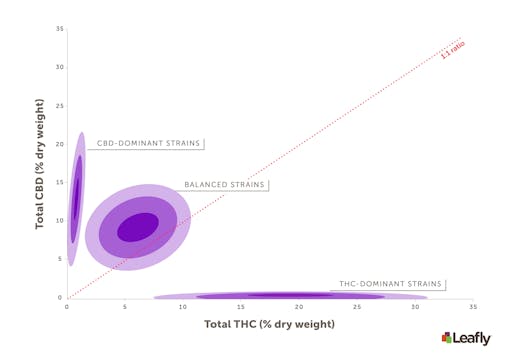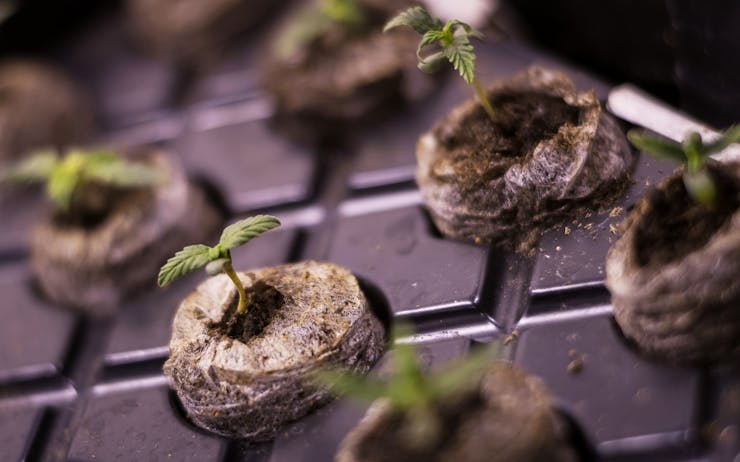Peak THC: The Limits on THC and CBD Levels for Cannabis Strains
For decades, growers have used selective breeding to create strains with ever-higher levels of THC. Some have done the same to produce low-THC, high-CBD profiles. But is there a limit on the THC or CBD levels that cannabiscan produce? Or will growers continue to pack more power per pound into the plant?
The answer is simple: There are limits. And today’s growers have probably already reached the natural limits with the most potent THC-dominant and CBD-dominant strains.
Because CBD and THC are ultimately derived from CBGA, and strain genetics limit how that happens, there are serious biological constraints on the THC:CBD ratios that strains can have. You can see this clearly by looking at a plot of THC vs. CBD content across many strains, which will look something like what you see in Figure 1.

Figure 1: THC and CBD levels generally fall within three broad ranges. Almost every strain will fall into one of these. 30% total THC by dry weight should be considered very potent, and it’s difficult to get plants to produce much more than that. Balanced strains will have both CBD and THC, but at intermediate levels. The very center of each trio of rings is the average THC and CBD content for that strain category. Each shade of purple represents one standard deviation. The majority of strains in each category will fall within the innermost, dark purple ring. Note: the THC-dominant rings have been stretched vertically for visualization purposes. (Photo credit: Amy Phung/Leafly)
Lab Data Shows Limits on THC and CBD Levels
The above graphic is based on real data—over 1,200 laboratory measurements from commercial strains in the state of Washington. Almost all strains fall into one of the three shaded regions above. And this isn’t anything new—botanists have known about this general pattern for years, and have used the THC:CBD ratio to classify landrace strains into three “chemotypes.”
Most commercial strains sit near the x-axis in Figure 1—they have high THC content and low or negligible CBD levels. By contrast, hemp strains sit near the y-axis because they produce CBD but very little THC. Balanced strains produce both CBD and THC, so they fall somewhere in the middle. THC-dominant strains make up the bulk of flower products on dispensary shelves, although balanced strains are rising in popularity due to increasing consumer interest in CBD.
What’s also interesting are the blank regions, where you should never expect a commercial strain to fall. In terms of THC content, ~8-10% dry weight marks the low end for common THC-dominant strains (although you can find some with lower levels). The most potent strains clock in at just over 30% THC by dry weight. You can occasionally find some that contain higher levels, but they’re rare.
But there is an upper limit. The biological limits on THC production mean that ~35% total THC by dry weight is a rough upper limit for strains. On average, high-THC strains contain ~18-20% total THC, while the more potent strains will contain ~25-30% total THC. You should almost never see a strain with more than 35% total THC by dry weight. Be skeptical if you do.
(Note: in the next article of this series, we’ll look more closely at what Total THC by % dry weight means, and how to read it on labels.)
Mixed strains are also limited in how much CBD and THC they can produce. They can’t produce as much THC as the more potent THC-dominant strains, and they can’t produce as much CBD as the more potent hemp strains. 20% total CBD by dry weight would be considered highly potent for a hemp strain.
Most balanced strains will tend to have CBD and THC levels in the neighborhood of ~6-12%. But you should never see a strain with 30% THC and 10% CBD, or one with 30% of both. The biology of THC and CBD production prevents this. Be skeptical if you see flower claiming to contain anything very far from the shaded purple regions in Figure 1.
Why Do These Limits Exist?
If you think about it, there are commonsense reasons why these limits exist. When appropriately labeled, cannabis products tell you how much THC, CBD, or other compounds are present as a percentage of the dry weight of that product. If the flower you buy is labelled as having 25% THC by dry weight, it means that 25% of the mass of the flower, after it has been dried to remove water, comes from THC. That means 75% of its dry weight comes from other things: fats, carbs, proteins, vitamins, and minerals. All that stuff. More THC or CBD means less of those things, which the plant depends on for survival.
But just knowing the % dry weight number isn’t enough if you want to know exactly how much THC you will really be dealing with when consuming your favorite strain. That’s because a lot of the “THC” in your product is really THCA, much of which will be converted into THC by the heat from your lighter, vape or oven. And this process isn’t 100% efficient, which means things aren’t so cut and dry that you can just read the numbers on the label.
In the next installment of this series, we’ll take a deeper dive into what “Total THC” really means, and how it can be calculated. After that, we’ll explore how the THC:CBD ratio might be used to predict relative differences in effects that different strains may have.





